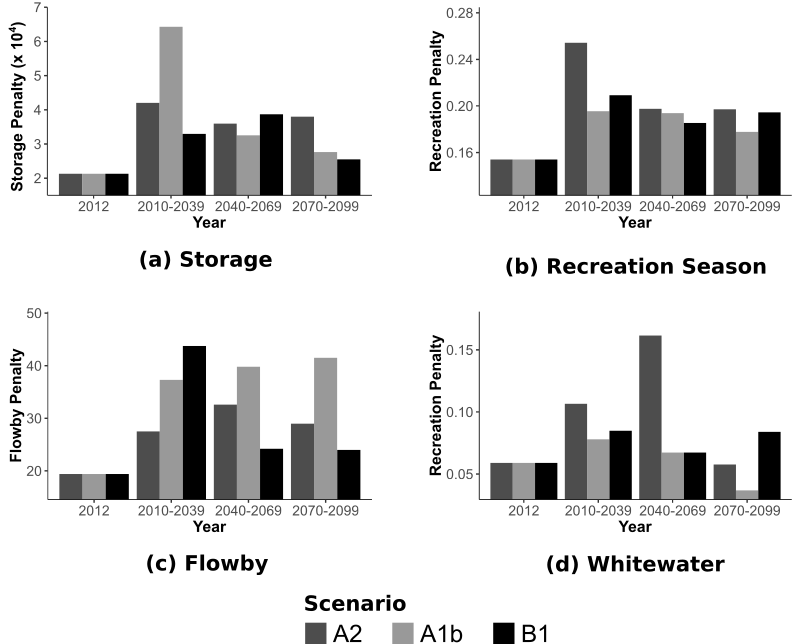
New Paper Published
Water resources adaptation to climate and demand change in the Potomac River
Water resources adaptation to climate and demand change in the Potomac River
Posted by Jim Stagge on September 13, 2017
My new paper, titled “Water resources adaptation to climate and demand change in the Potomac River”, has just been published online. This study extends prior optimization work to consider how water resources could be managed in the Washington DC area to adapt to climate change and future demand increases.
You can read the full paper here:
Stagge, J.H. and Moglen, G.E. (2017) "Water resources adaptation to climate and demand change in the Potomac River." Journal of Hydrologic Engineering, 22 (11), 04017050.

Fig. 1. Reproduced from article. Potomac watershed and Washington, DC, water supply; Potomac watershed shown in lighter shade, with reservoir watershed shown in a darker shade; reservoirs shown as triangles and intakes for the Washington, DC, metropolitan area shown as a hashed circle.
This study begins by measuring the projected changes in drought vulnerability for the near (2010 to 2039), intermediate (2040-2069), and distant future (2070 to 2099) under climate and demand changes. A system-wide increase in demand of 23\% by the year 2040 is projected to decrease available storage in the Jennings Randolph Reservoir, decreasing the number of Recreation days, measured above lake access points. Increased demand is also projected to increase the load on downstream reservoirs, resulting in an increase in consecutive low flow days. WMA reservoirs are projected to lose 7 to 15\% of their usable storage volume due to sedimentation between 2010 and 2040, causing an increase in storage failures.
Simulations of climate change result in higher flows in the winter and early spring, followed by more extreme low flows in the summer. This causes an increase in reservoir storage failures combined with a lack of whitewater releases and decrease in reservoir boat access.

Fig. 3. Reproduced from article. Effect of climate change on system objectives. Lines represent the mean of all five considered GCMs for the SRES A2, A1b, and B1 emission scenarios.
The second part of the paper focuses on adaptation strategies for the region. None of the optimized operating rules were able to completely mitigate the combined effects of demand change, sedimentation and climate changes. However, the Buffer Equation, controlling upstream/downstream reservoir preference was able to mitigate the effect of climate change alone by relying more on upstream storage. Also, given the seasonal shift in flows, optimized rules suggested a more conservative approach during March, April and May in the future.

Fig. 4. Reproduced from article. Optimized buffer equation under 2070-2099 climate change conditions with respect to Flowby (a) and Recreation Season (b). Current operating rules are shown by the diagonal, black line. Each non-dominated solution is presented with the color scale corresponding to improvement (green) or worsening (red) of the objective function relative to current policy.
Abstract
The effects of climate change are increasingly considered in conjunction with changes in water demand and reservoir sedimentation in forecasts of water supply vulnerability. Here, the relative effects of these factors are evaluated for the Washington, DC metropolitan area water supply for the near (2010 to 2039), intermediate (2040-2069), and distant future (2070 to 2099) by repeated water resources model simulations. This system poses water management challenges due to long water delivery travel times that increase uncertainty, multiple water jurisdictions that constrain potential decisions, and future scenarios that simultaneously increase demand and decrease water supply during the critical summer period. Adaptation strategies were developed for the system using a multi-objective evolutionary algorithm. Optimized reservoir management policies were compared using six distinct objectives, ranging from reservoir storage to environmental and recreational benefits. Simulations of future conditions show water stress increasing with time. Reservoir sedimentation is projected to more than double (114% increase) the severity of reservoir storage failures by 2040. Increases in water demand and climate change are projected to further stress the system, causing longer periods of low flow and a loss of recreational reservoir storage. The adoption of optimized rules mitigates some of these effects, most notably returning simulations of 2070-2099 climate to near historical levels. Modifying the balance between upstream and downstream reservoirs improved storage penalties by 20.7% and flowby penalties by 50\%. Changing triggers for shifting load to off-line reservoirs improved flowby (8.3%) and environmental (4.1%) penalties slightly, while changing demand restriction triggers provided only moderate improvements, but with little adverse effects.